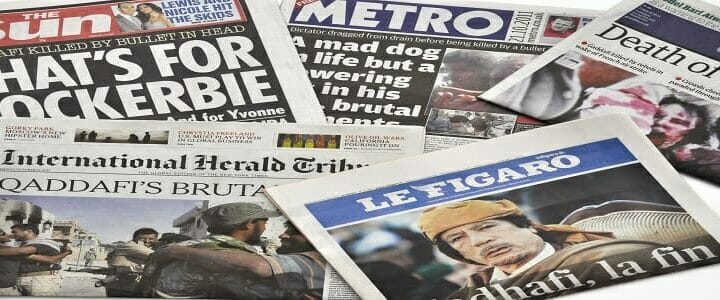Speaking to reporters Thursday afternoon, President Trump spoke out about the tensions between the United States and the Democratic People’s Republic of Korea over the impending denuclearization summit. Seemingly contradicting his national security adviser, John Bolton, the president said, “the Libya Model isn’t the model that we have at all when we’re thinking of North Korea. ” But Trump’s next statement revealed the fact that he wasn’t really contradicting Bolton, he just doesn’t understand what the “Libya Model” really is.
“In Libya, we decimated that country. That country was decimated,” Trump said. Forgetting for a moment the pedantic retort that “decimate,” derives from the Roman practice of randomly killing one in ten of its own soldiers as punishment for serious crimes, the Obama administration’s actions in 2011 are not what defines the policy.
in the Libya Model, Khaddafi Caved
For decades, Libyan dictator Muhammar Khaddafi was a thorn in America’s side. As I’ve believed since the early 1980s, never trust a man who leads a coup and doesn’t promote himself past colonel. In what became known as the first Gulf of Sidra incident in 1981, two U.S. Navy F-14 Tomcats splashed two Soviet-made Libyan F-22 “Fitter” fighters. In April 1986, terrorists funded by Libya bombed a Berlin discotheque, killing one American soldier and wounding another who died two months later. President Ronald Reagan bombed Tripoli in retaliation.
In December 1988, Pan Am flight 103 exploded over Lockerbie, Scotland, killing 259 people on the aircraft, including a contingent of 35 college students from Syracuse University returning from a semester abroad, and another 11 people on the ground. Libya was widely blamed. Finally, in 1999, Libya handed over the two men responsible for the bombing, one of whom was convicted in 2001. Khaddafi admitted responsibility in 2003 (as part of the Libya Model).
After the U.S. invaded Iraq in 2003, Khaddafi suddenly changed his tune. The pretext for the invasion was Iraq’s supposed chemical and nuclear weapons program. We know now that Iraq had ended its program when it was supposed to, but that Saddam Hussein wanted his neighbors to think he still had WMD. Saddam miscalculated and paid the price.
An intelligence operation had secured documents proving the existence of the Libyan WMD program, and that knowledge, combined with the decisiveness of the U.S. action against Iraq, unnerved Khaddafi. He approached the West with a proposal: if the U.S., Great Britain, and their allies would promise not to pursue regime change in Libya, he would voluntarily surrender his nuclear weapons development program.
Why North Korea doesn’t like this comparison
The Libya Model was, at the time, a triumph. A ruthless dictator, who had been a massive state sponsor of terrorism for years, who was actually trying to build a nuclear weapon, and who had made his reputation attacking the U.S., had surrendered. But it wasn’t to last.
Those who complain about Trump withdrawing from the Iran nuclear deal – and who don’t decry Obama’s behavior in Libya – have selective memory. Despite the deal cut by President George W. Bush, when the Arab Spring arrived in 2011 and the people rose against Khaddafi, President Obama cut sling load.
Despite the deal with Bush that giving up his WMD would spare his rule, when civil war erupted, U.S. air power attacked regime targets. On October 20, rebels captured Khaddafi outside the city of Sirte. The mob beat him to death while a cell phone recorded the event for posterity.
This is the result Trump is recalling when he says we don’t want to use the Libya Model as a template for North Korea. But in reality, the model itself was a success. Obama simply couldn’t resist the opportunity to take Khaddafi down. At the time, few Americans could blame him for supporting the people who were taking out one of the country’s most longstanding enemies. But in the long run, bombing the Khaddafi regime hurt U.S. credibility.
When North Korea says it doesn’t think the Libya Model is the right example to follow, it isn’t thinking of the part where Khaddafi gave up his nuclear program in exchange for the easing of sanctions. It is thinking about the part where the U.S. went back on its word and aided those who overthrew him. Libya remains a failed state to this day.
The DPRK first vice minister of foreign affairs, Kim Kye-gwan, said as much. “This is not an expression of intention to address the issue through dialogue,” Kim said of U.S. suggestions that following the Libya Model was the best path forward. “It is essentially a manifestation of awfully sinister move to impose on our dignified state the destiny of Libya or Iraq which had been collapsed due to yielding the whole of their countries to big powers.”
Frankly, Trump needs to understand what he’s talking about before going in front of the press. The Libyan Model, faithfully executed, is a fine blueprint for peace. He just doesn’t understand what it really means. And that misunderstanding only plays into the North Koreans’ hands.




